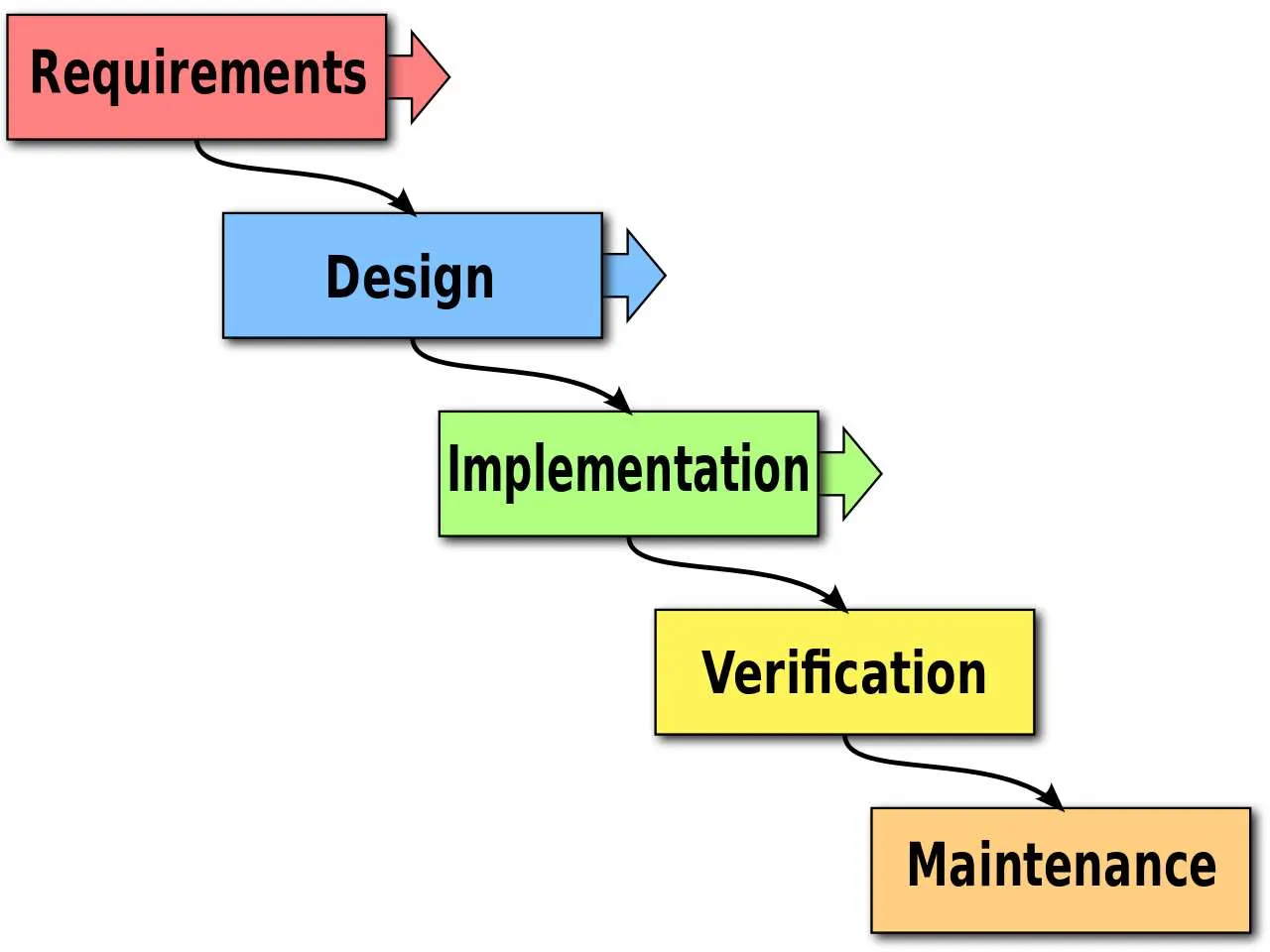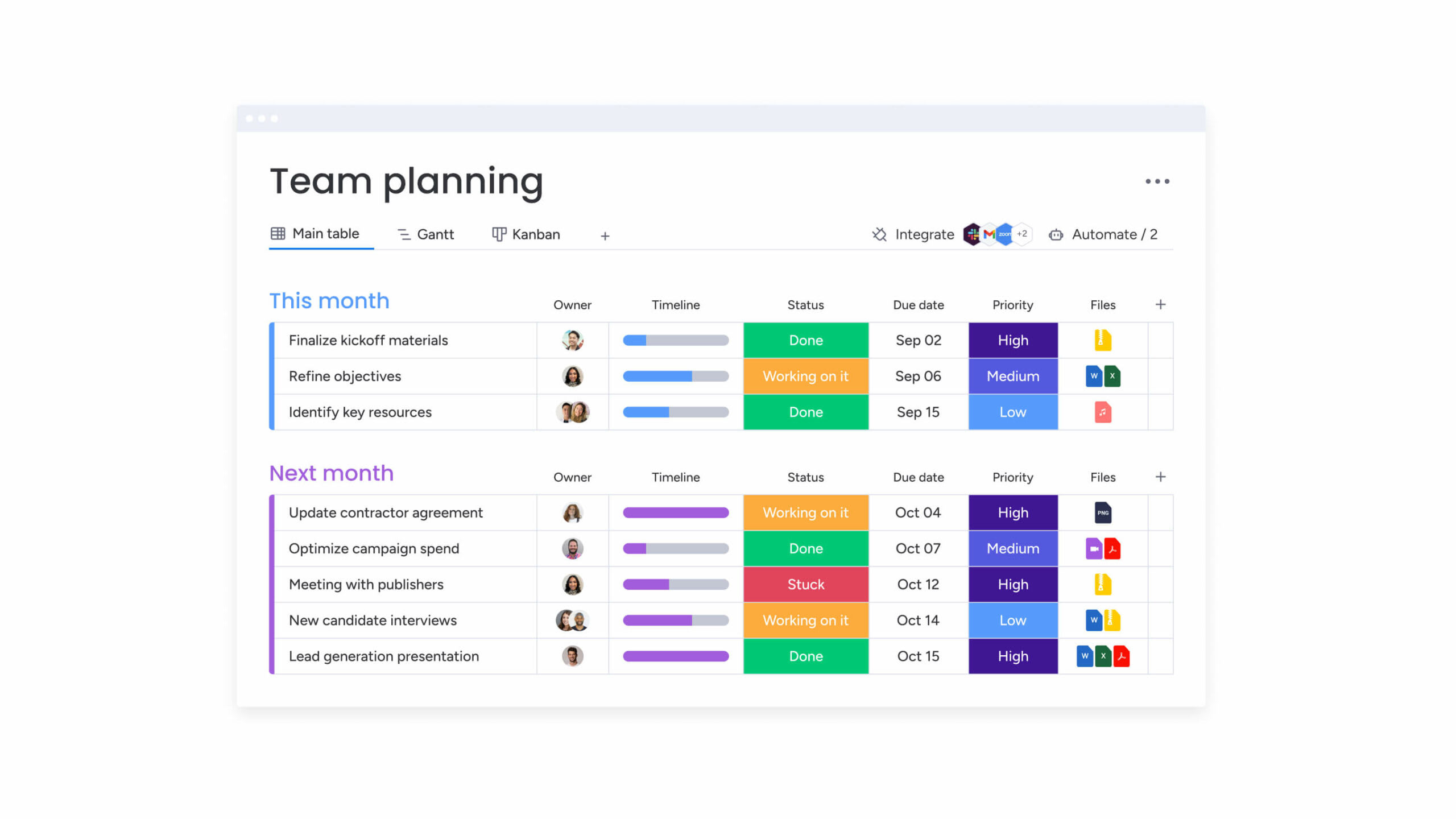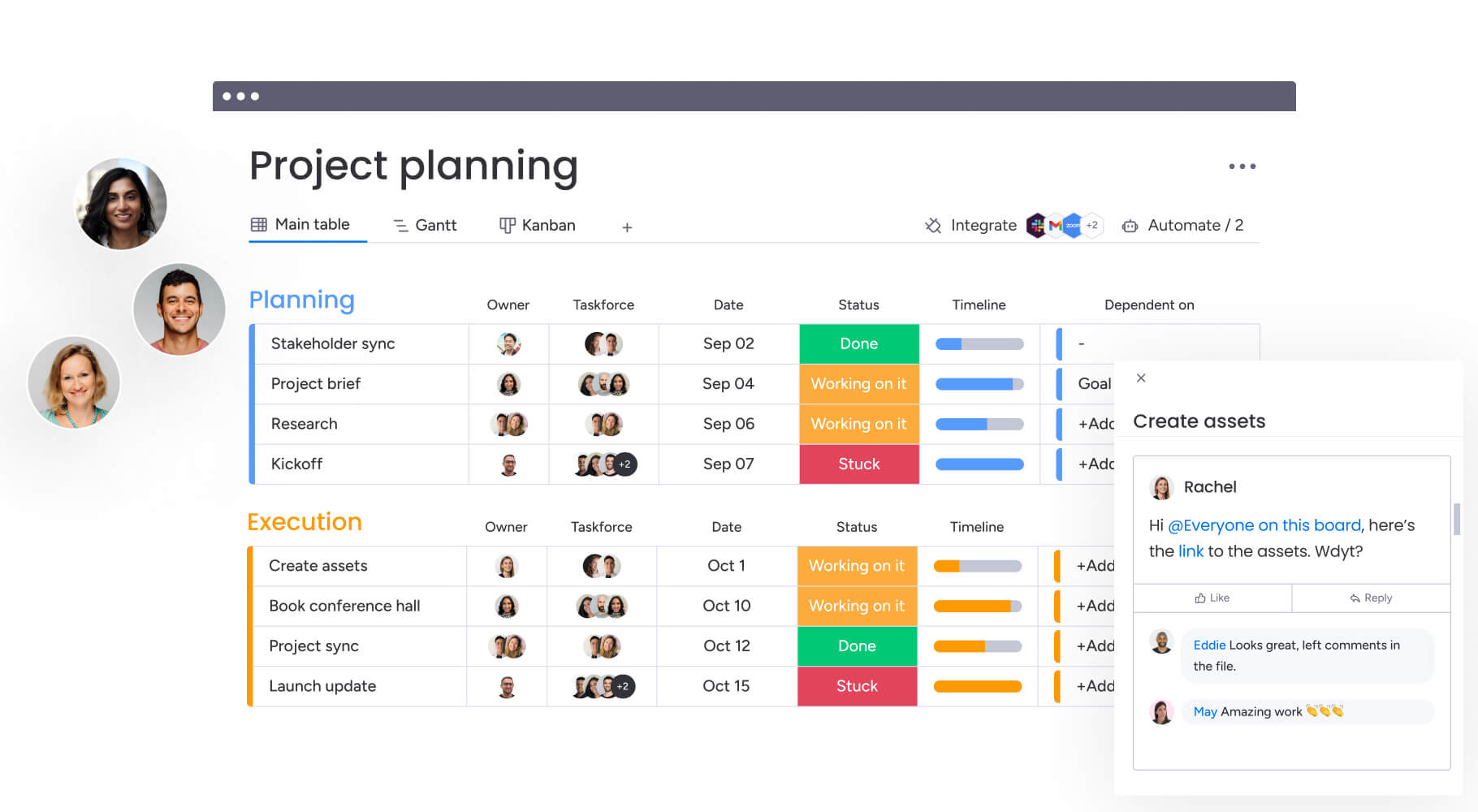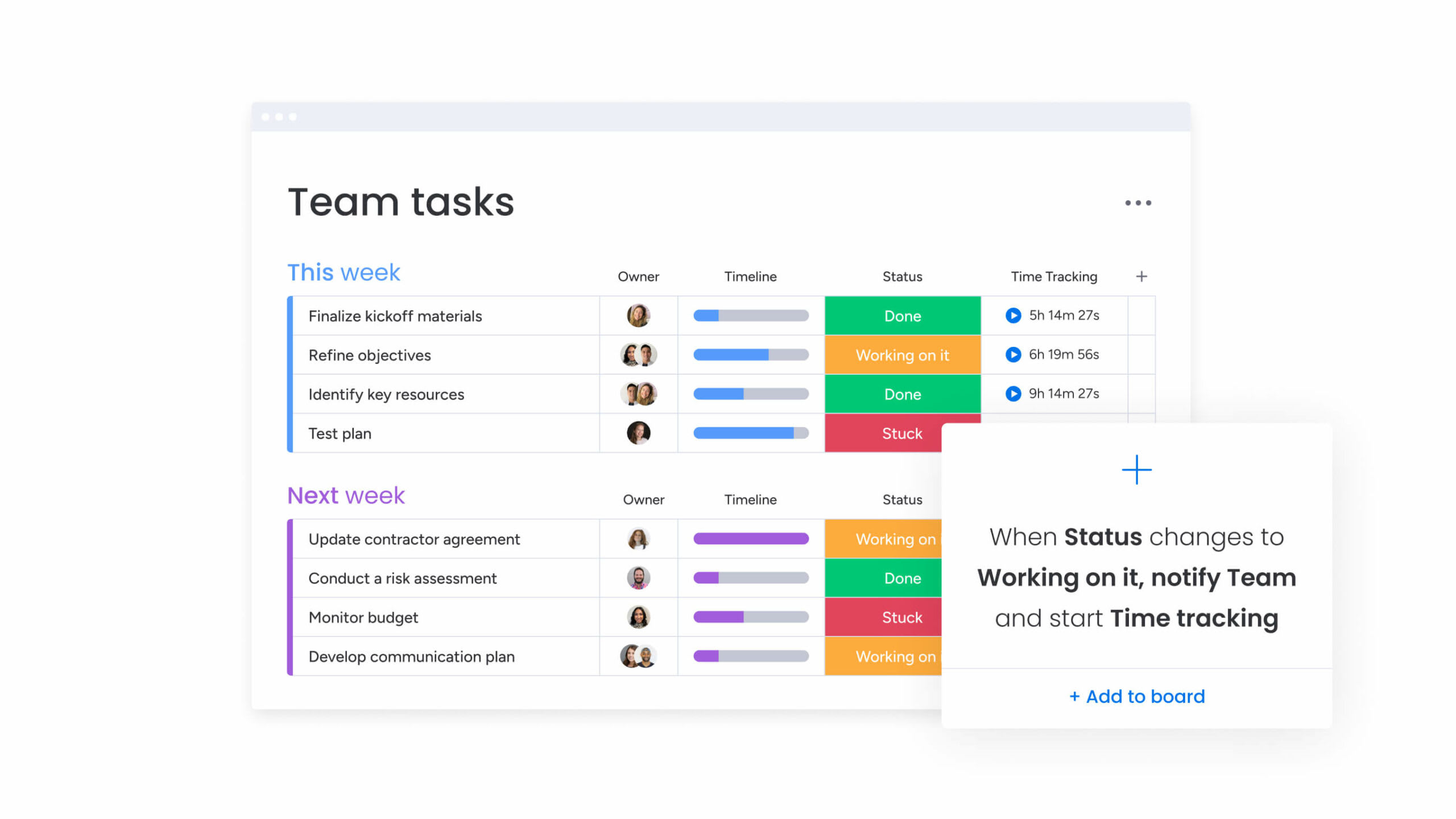There are different methodologies project managers can choose from when beginning new projects, such as Agile, Gantt, Kanban, and more. If you’ve worked in project management for a little while, there’s no doubt you’ve come across the Waterfall methodology.
For projects that require a more linear approach, the Waterfall methodology is a tried and true model for helping your team reach project goals. Often used by software developers, the Waterfall methodology has been used and recycled in different ways over the last few decades.
In this blog post, we’ll take a more detailed look at the Waterfall methodology, including its five core phases, benefits and limitations, and how it’s used today in conjunction with platforms like monday work management.
Get startedWhat is the Waterfall methodology?
The Waterfall methodology, also referred to as the Waterfall model, is a sequential approach to project management where projects (often software development projects) are broken down into sequential linear phases. Each phase leads into the next, flowing like a waterfall, and relies on deliverables from the one before, meaning phases need to be completed before moving on.
Originating from a 1970s research paper by Winston W. Royce, this linear approach allows you to plan and set a structure for the project early on, making it easier to execute and manage project progress. This model can also help make projects more predictable in terms of milestones, deliverables, and release dates as time estimates are often more accurate. That said, it’s not quite as flexible as other methodologies such as the Agile approach since your team can’t jump ahead to another phase until problems are completely solved.
Traditionally, the Waterfall model divides a project into 5 specific phases or stages. Below, we’ll take a closer look at each of the phases in more detail.
What are the 5 phases of the Waterfall method?

The Waterfall methodology is made up of five core phases that occur in chronological order. These phases each have set dates, requirements, and deliverables, and following the phases is like following a clearly laid out project plan. Here’s a closer look at each of the phases.
1. Requirements
The requirements phase is when teams and managers estimate project requirements and assess the viability of a project or proposed solution. During the requirements phase, you’ll look at project scope, stakeholder expectations, company goals, and more upfront. It’s the project manager’s job to get a detailed understanding of the project’s requirements including:
- Objectives: Stakeholder expectations and business goals to set project objectives
- Project scope: Figure out the overall extent of collaboration with stakeholders
- Risk assessment: Find potential risks and assess whether a project is worth undertaking
- Research: Conduct market research to inform the product development process
- Resources and manpower: Start assembling resources and talent for your project
- Timeline: Put together a specific project timeline
Too many projects fail because management overlooks something at the requirements stage. In the requirements stage, it’s essential to look past basic business requirements and involve stakeholders in the process.
2. Design
In the design phase, you’ll be focused on outlining project specifics. At this stage, you should have a preliminary project team and you should:
- Create and plan the project schedule and milestones
- Determine the project’s deliverables
- Create a physical design or blueprint for the final deliverables
In the design stage, you may want to consider using a work breakdown structure (WBS) to start assigning project activities. You can also create a high-level project schedule with clear project milestones that you can use to benchmark progress.
3. Implementation

In this phase, you’ll begin implementing the plan and making the project a reality. Once you start getting into the core of a project, it’s easy to have tunnel vision and lose sight of the original plan. This stage’s goal is to put the gears in motion to successfully implement your project plan. In this phase, you should:
- Start actioning development based on plans from the previous phase
- Track project progress and key KPIs by seeing how you measure up against milestones using a project management platform like monday work management
- Continuously try to identify potential roadblocks and bottlenecks to project progress
Changes are possible in this stage, but it may require heading back to the design phase so each request should be carefully considered.
Get started4. Verification
This stage is all about testing and checking that the resulting product or feature solves the intended problem. Just because you’ve delivered the project objective doesn’t mean it’s time to celebrate just yet. You need to make sure that the product holds water.
In this stage, you’ll be implementing various quality assurance steps such as:
- Documenting bugs to be addressed and fixed
- Arranging direct user testing with existing or potential customers
- Getting the necessary regulatory approvals
- Standardizing any repeatable processes that deliver results
It’s important to first determine which QA metrics you want to track and then test your product in different use cases and environments to make sure it holds up.
5. Maintenance
The last part of the Waterfall project lifecycle, the maintenance phase, ensures that the project delivers in the long term. This stage is all about phasing out older products, implementing a maintenance plan for the new machinery, and supporting the product after project completion.
In this phase, teams will need to:
- Respond to customers when defects are found
- Address change requests from users
- Release updates, patches, and new versions of your product
When should you use the Waterfall methodology?
The Waterfall methodology is the best choice for reasonably predictable projects with strict time constraints or flawless operation requirements. These projects can come in many shapes and sizes and in many different industries. Some examples include:
- Projects where you fully understand the scope through previous experience and there are well-defined requirements
- Software development projects where the end goals are defined from the outset
- Projects in industries with strict regulations or where thorough documentation is required, like construction or aerospace
- Manufacturing or construction projects where there’s no room for variation in schedule or implementation
- Projects with strict timelines or schedule constraints
- Projects for clients who aren’t very likely to change the scope or requirements as work progresses
What are the benefits of the Waterfall methodology?
The biggest advantage of the Waterfall methodology is the ability to create and control a predictable schedule and by extension, outcomes, for projects where timing is critical. The distinct benefits of Waterfall make it an excellent choice for a lot of teams and projects. Some other benefits of the Waterfall process include:
- Predictability: The detailed schedule means each team and individual knows what they should be working on
- Repeatable: By outlining entire workflows, you can easily standardize and create a repeatable process to apply to multiple projects
- Reasonable: With a well-planned budget including contingency costs, it’s easier to allocate resources to a project
- Structured: With distinct phases to follow, it’s simpler to measure progress against set milestones
- Cost-efficient: By accurately estimating customer requirements and a timeline, it’s a lot easier to stick to a project’s budget
- Error-avoidant: Risks and potential errors are caught early during the planning phases, helping teams avoid costly mistakes during implementation
What are the drawbacks of the Waterfall methodology?
For long-term projects with lofty goals and lots of unpredictability, the Waterfall model probably isn’t the best choice. While it has many strengths, there are drawbacks that can make it unsuitable for certain types of projects with varying requirements and timelines. Some of the drawbacks of the Waterfall methodology to consider include:
- Lack of flexibility: Once a phase is finished, it’s difficult to go back and make changes without disrupting the entire project’s process
- Longer delivery: Projects can take longer to deliver since all phases need to be completed, unlike other models like Agile project management that push iterative development
- Limited client involvement: Customers aren’t as involved in Waterfall model projects and review deliverables at the end, so feedback doesn’t get implemented throughout
- Relies on clear requirements: Projects with ambiguous requirements from the get-go can get stalled in the Waterfall model, making it not so ideal for dynamic environments
- Deadline creep: If a serious issue comes up during one phase, all the others are impacted, and if nothing is moving forward, deadlines can be significantly delayed
Who uses the waterfall model?
A wide range of teams and companies still use the Waterfall methodology in multiple industries. That said, according to various research and studies, other project management methodologies lead to more successful projects. For example, research shows that companies using Agile project management saw a 64% success rate, compared to just a 49% success rate for the Waterfall model.
While many claim that the Waterfall approach is outdated or obsolete, that’s not entirely true. The Waterfall method brings with it many benefits, as we saw above, and traditional methodologies like Waterfall still prove to be some of the most popular project management methodologies among professionals.
While Agile may seem to get all the glory, the truth is that you don’t need to commit 100% to one methodology or another. The Waterfall project management methodology can be used as a foundation that you can add to. For many teams, hybrid approaches that combine the benefits of models like Waterfall and Agile can offer the best of both worlds.
In fact, according to the latest surveys, teams are using hybrid approaches more than ever. Since 2020, hybrid project management approaches have increased from 20% to 31% in 2023 and are being used for complex projects in industries like IT, construction, healthcare, and finance. For this reason, understanding the core of how traditional models like Waterfall function is essential for implementing the right hybrid approach in your team.
Take Waterfall project management to the next level with monday work management
Choosing the right methodology for your project is an essential first step, but the next thing that will take your project management abilities to the next level is selecting the right project management software. monday work management helps teams organize projects in a way that’s both visual and entirely customizable, so whether you’re using a strict Waterfall model or a hybrid model combining different methodologies, you’ll be able to organize, track, and collaborate on your project and related tasks all in one place.

What sets monday work management apart is that it’s equipped with a host of tools that allow you to build the exact project management platform your company needs. With smart automations, tons of native integrations with other tools, and an interface that makes sense, you’ll feel like you hired an extra project manager. Here’s a look at just a few features that make monday work management stand out.
Ready-made customizable templates and work views

Work your way using monday work management’s ready-made project templates to help you kickstart your project. You can choose a template that fits your project management methodology and then customize it to your team’s liking. Then, view tasks in over 27 different work views such as Calendar, Timeline, Gantt, Workload, process map and others, to visualize projects any way you want.
Advanced analytics for stronger verification and maintenance

As core parts of the Waterfall methodology, successfully verifying and maintaining your products involves having access to accurate and real-time data. With monday work management, you can always maintain a bird’s eye view of your project with dashboard analytics and automated reports that give you insights into project progress and task status.
Improve collaboration with integrations and automations

With monday work management, your team can work better by integrating all their work tools with the platform. With over 200 app integrations, you can rest assured that your team is communicating efficiently in one unified space rather than staggered across various applications. Then, you can build custom no-code automations to trigger actions or reminders from third-party apps or different tasks so that nothing falls through the cracks or causes delays.
Get startedUse the right platform to succeed with Waterfall project management
Contrary to what you might have heard, the Waterfall methodology isn’t “dead.” In fact, it’s alive and well, simply evolving to meet the needs of modern project management. While many project managers still use it in its purest form, adopting a hybrid approach has proven to be beneficial to a diverse range of projects.
Furthermore, when you use the Waterfall or a hybrid model with a platform like monday work management, you can add a level of flexibility, accuracy, and insight to help you optimize each project stage.
FAQs
What are the 3 principles of Waterfall methodology?
The three principles of the Waterfall methodology include little to no client or stakeholder involvement, a strict and linear project with a structured approach, and detailed project and process documentation. Implementing these principles makes adhering to the Waterfall methodology easier.
What is the difference between Scrum and Waterfall?
Both Scrum and Waterfall are different project management methodologies. While Waterfall is focused on linear processes and sequential phases with upfront planning, Scrum offers a more flexible and iterative approach. Scrum also involves more customer feedback throughout various processes, making it more adaptable to change, whereas with Waterfall feedback only comes in at the end.
When to use Agile vs Waterfall vs hybrid?
The Agile methodology focuses much less on up-front planning than Waterfall and instead on iterative development. When considering different models, it’s best to consider project needs. Waterfall is a more rigid and linear methodology so it’s best if you don’t anticipate many changes. Agile is easier to adapt so if your project requires higher flexibility, it could be the right choice. A hybrid model is more customizable and can fall somewhere in between, so if you need a linear model that still offers flexibility, this could be the right choice.
What is an example of a waterfall model in real life?
An example of the Waterfall model in real life could be developing a software system. First, the requirements are fully gathered and documented, followed by designing the system architecture, then coding, and finally the testing phase and deployment. Each project phase is completed in sequence, with the development team ensuring that the software meets regulatory and security standards.
What’s the difference between Kanban and Waterfall?
Kanban is a framework within the Agile method that’s focused on flexibility and ongoing adaptation. However, instead of dividing a project into sprints, your Agile team is focused on continuous improvement. Unlike with Waterfall, in a Kanban model you maintain the original company structure, involve stakeholders more, and give every employee a platform to voice their ideas.
